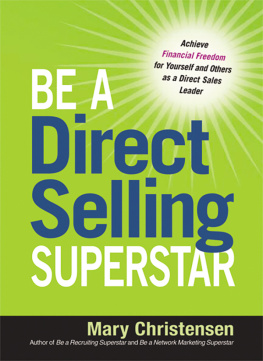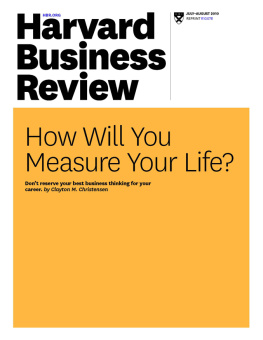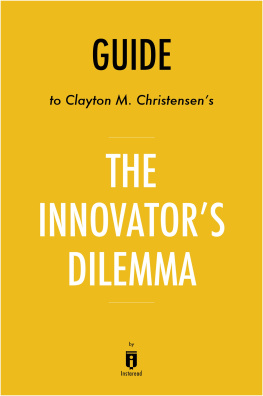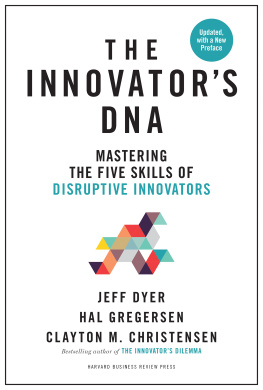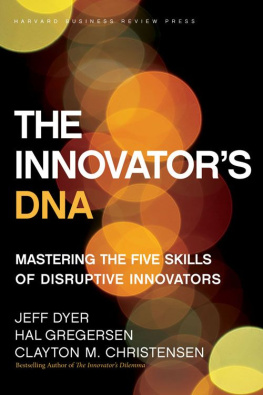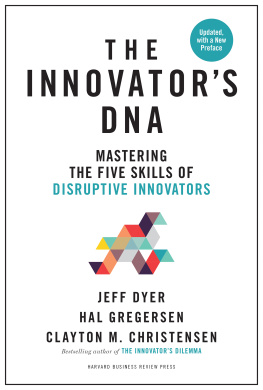Christensen - The innovators dilemma: when new technologies cause great firms to fail
Here you can read online Christensen - The innovators dilemma: when new technologies cause great firms to fail full text of the book (entire story) in english for free. Download pdf and epub, get meaning, cover and reviews about this ebook. City: Boston;Massachusetts, year: 1996;2016, publisher: Harvard Business Review Press, genre: Business. Description of the work, (preface) as well as reviews are available. Best literature library LitArk.com created for fans of good reading and offers a wide selection of genres:
Romance novel
Science fiction
Adventure
Detective
Science
History
Home and family
Prose
Art
Politics
Computer
Non-fiction
Religion
Business
Children
Humor
Choose a favorite category and find really read worthwhile books. Enjoy immersion in the world of imagination, feel the emotions of the characters or learn something new for yourself, make an fascinating discovery.

- Book:The innovators dilemma: when new technologies cause great firms to fail
- Author:
- Publisher:Harvard Business Review Press
- Genre:
- Year:1996;2016
- City:Boston;Massachusetts
- Rating:3 / 5
- Favourites:Add to favourites
- Your mark:
- 60
- 1
- 2
- 3
- 4
- 5
The innovators dilemma: when new technologies cause great firms to fail: summary, description and annotation
We offer to read an annotation, description, summary or preface (depends on what the author of the book "The innovators dilemma: when new technologies cause great firms to fail" wrote himself). If you haven't found the necessary information about the book — write in the comments, we will try to find it.
The innovators dilemma: when new technologies cause great firms to fail — read online for free the complete book (whole text) full work
Below is the text of the book, divided by pages. System saving the place of the last page read, allows you to conveniently read the book "The innovators dilemma: when new technologies cause great firms to fail" online for free, without having to search again every time where you left off. Put a bookmark, and you can go to the page where you finished reading at any time.
Font size:
Interval:
Bookmark:
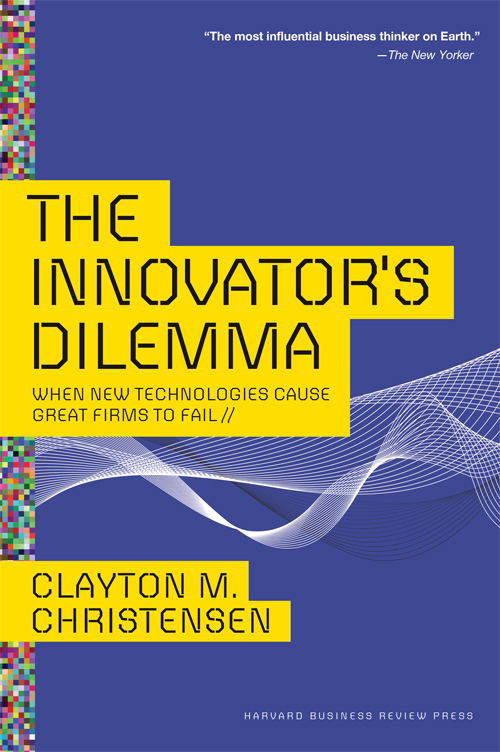
Copyright 1997, 2000 by the President and fellows of Harvard College
All rights reserved
No part of this publication may be reproduced, stored in or introduced into a retrieval system, or transmitted, in any form, or by any means (electronic, mechanical, photocopying, recording, or otherwise), without the prior permission of the publisher. Requests for permission should be directed to permissions@hbsp.harvard.edu, or mailed to Permissions, Harvard Business School Publishing, 60 Harvard Way, Boston, Massachusetts 02163.
ISBN: 978-1-4221-9602-1
THE MANAGEMENT OF INNOVATION AND CHANGE SERIES
Michael L. Tushman and Andrew H. Van de Ven, Series Editors
Emerging Patterns of Innovation: Sources of Japans Technological Edge
Fumio Kodama, with a Foreword by Lewis M. Branscomb
Crisis  Renewal: Meeting the Challenge of Organizational Change
Renewal: Meeting the Challenge of Organizational Change
David K. Hurst
Winning through Innovation: A Practical Guide to Leading Organizational
Change and Renewal
Michael L. Tushman
Charles A. OReilly III
Imitation to Innovation: The Dynamics of Koreas Technological Learning
Linsu Kim
The Innovators Dilemma: When New Technologies Cause Great Firms to Fail
Clayton M. Christensen
Although this book lists only one author, in reality the ideas it molds together were contributed and refined by many extraordinarily insightful and selfless colleagues. The work began when Professors Kim Clark, Joseph Bower, Jay Light, and John McArthur took the risk of admitting and financing a middle-aged mans way into and through the Harvard Business Schools doctoral program in 1989. In addition to these mentors, Professors Richard Rosenbloom, Howard Stevenson, Dorothy Leonard, Richard Walton, Bob Hayes, Steve Wheelwright, and Kent Bowen helped throughout my doctoral research to keep my thinking sharp and my standards for evidence high, and to embed what I was learning within the streams of strong scholarship that had preceded what I was attempting to research. None of these professors needed to spend so much of their busy lives guiding me as they did, and I will be forever grateful for what they taught me about the substance and process of scholarship.
I am similarly indebted to the many executives and employees of companies in the disk drive industry who opened their memories and records to me as I tried to understand what had driven them in the particular courses they had taken. In particular, James Porter, editor of Disk/Trend Report, opened his extraordinary archives of data, enabling me to measure what has happened in the disk drive industry with a level of completeness and accuracy that could be done in few other settings. The model of the industrys evolution and revolution that these men and women helped me construct has formed the theoretical backbone for this book. I hope they find it to be a useful tool for making sense of their past, and a helpful guide for some of their decisions in the future.
During my tenure on the Harvard Business School faculty, other colleagues have helped refine this books ideas even more. Professors Rebecca Henderson and James Utterback of MIT, Robert Burgelman of Stanford, and David Garvin, Gary Pisano, and Marco Iansiti of the Harvard Business School have been particularly helpful. Research associates Rebecca Voorheis, Greg Rogers, Bret Baird, Jeremy Dann, Tara Donovan, and Michael Overdorf; editors Marjorie Williams, Steve Prokesch, and Barbara Feinberg; and assistants Cheryl Druckenmiller, Meredith Anderson, and Marguerite Dole, have likewise contributed untold amounts of data, advice, insight, and work.
I am grateful to my students, with whom I have discussed and refined the ideas put forward in this book. On most days I leave class wondering why I get paid and why my students pay tuition, given that it is I who have learned the most from our interactions. Every year they leave our school with their degrees and scatter around the world, without understanding how much they have taught their teachers. I love them and hope that those who come across this book will be able to recognize in it the fruits of their puzzled looks, questions, comments, and criticisms.
My deepest gratitude is to my familymy wife Christine and our children Matthew, Ann, Michael, Spencer, and Catherine. With unhesitating faith and support they encouraged me to pursue my lifelong dream to be a teacher, amidst all of the demands of family life. Doing this research on disruptive technologies has indeed been disruptive to them in terms of time and absence from home, and I am forever grateful for their love and support. Christine, in particular, is the smartest and most patient person I have known. Most of the ideas in this book went home on some night over the past five years in half-baked condition and returned to Harvard the next morning having been clarified, shaped, and edited through my conversations with her. She is a great colleague, supporter, and friend. I dedicate this book to her and our children.
Clayton M. Christensen
Harvard Business School
Boston, Massachusetts
April 1997
This book is about the failure of companies to stay atop their industries when they confront certain types of market and technological change. Its not about the failure of simply any company, but of good companiesthe kinds that many managers have admired and tried to emulate, the companies known for their abilities to innovate and execute. Companies stumble for many reasons, of course, among them bureaucracy, arrogance, tired executive blood, poor planning, short-term investment horizons, inadequate skills and resources, and just plain bad luck. But this book is not about companies with such weaknesses: It is about well-managed companies that have their competitive antennae up, listen astutely to their customers, invest aggressively in new technologies, and yet still lose market dominance.
Such seemingly unaccountable failures happen in industries that move fast and in those that move slow; in those built on electronics technology and those built on chemical and mechanical technology; in manufacturing and in service industries. Sears Roebuck, for example, was regarded for decades as one of the most astutely managed retailers in the world. At its zenith Sears accounted for more than 2 percent of all retail sales in the United States. It pioneered several innovations critical to the success of todays most admired retailers: for example, supply chain management, store brands, catalogue retailing, and credit card sales. The esteem in which Sears management was held shows in this 1964 excerpt from Fortune: How did Sears do it? In a way, the most arresting aspect of its
Yet no one speaks about Sears that way today. Somehow, it completely missed the advent of discount retailing and home centers. In the midst of todays catalogue retailing boom, Sears has been driven from that business. Indeed, the very viability of its retailing operations has been questioned. One commentator has noted that Sears Merchandise Group lost $1.3 billion (in 1992) even before a $1.7 billion restructuring charge. Sears let arrogance blind it to basic changes taking place in the American marketplace. Another writer has complained,
Sears has been a disappointment for investors who have watched its stock sink dismally in the face of unkept promises of a turnaround. Sears old merchandising approacha vast, middle-of-the-road array of mid-priced goods and servicesis no longer competitive. No question, the constant disappointments, the repeated predictions of a turnaround that never seems to come, have reduced the credibility of Sears management in both the financial and merchandising communities.
Font size:
Interval:
Bookmark:
Similar books «The innovators dilemma: when new technologies cause great firms to fail»
Look at similar books to The innovators dilemma: when new technologies cause great firms to fail. We have selected literature similar in name and meaning in the hope of providing readers with more options to find new, interesting, not yet read works.
Discussion, reviews of the book The innovators dilemma: when new technologies cause great firms to fail and just readers' own opinions. Leave your comments, write what you think about the work, its meaning or the main characters. Specify what exactly you liked and what you didn't like, and why you think so.


